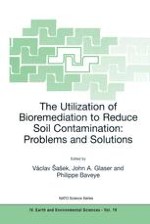2003 | OriginalPaper | Buchkapitel
Comparison of Effective Organisms in Bioremediation Processes: Potential Use of Nucleic Acid Probes to Estimate Cyanide Degradation in Situ
verfasst von : M. Barclay, A. Tabouret, J. C. Day, I. P. Thompson, C. J. Knowles, M. J. Bailey
Erschienen in: The Utilization of Bioremediation to Reduce Soil Contamination: Problems and Solutions
Verlag: Springer Netherlands
Enthalten in: Professional Book Archive
Aktivieren Sie unsere intelligente Suche, um passende Fachinhalte oder Patente zu finden.
Wählen Sie Textabschnitte aus um mit Künstlicher Intelligenz passenden Patente zu finden. powered by
Markieren Sie Textabschnitte, um KI-gestützt weitere passende Inhalte zu finden. powered by
Contamination of the environment with cyanide and its metal complexes is a major environmental problem. Fungi that degrade cyanide and metal complexes through induction of the enzyme cyanide hydratase were studied. The screening of six Fusarium strains demonstrated that cyanide degrading activity was inducible, a trait that is possibly common to the genus. Following sequence alignment probes were designed for cyanide hydratase (chy) allowing the application of molecular probes to amplify the gene (DNA), and amplification of mRNA by RT-PCR to measure degradative potential. DNA sequence analysis of the chy gene shows a high degree of homology between species. Interspecies variation within chy allows the application of tools such as RT-PCR denaturing gradient gel electrophoresis (DGGE) to determine that fungi actually degrade cyanide within a community.
